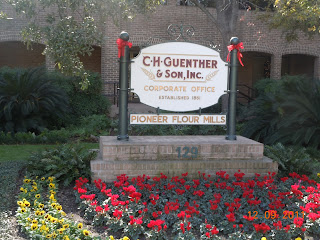One of the most historic landmarks in San Antonio Texas and one visited by thousands of tourists annually is the Guenther House located on a bend of the San Antonio River, at the foot of King William, the oldest historical district in Texas. The Guenther home has been completely restored and is now open for your visiting and dining pleasure. The Guenther House today serves as one of the more popular San Antonio restaurants and a true historic Texas landmark. The house is a very interesting museum and library Museum, or library which contains mill memorabilia including antique baking accessories, cookie cutters and anniversary Dresden china plates.Located adjacent to the Pioneer Flour Mill, you will also find a very good selection of baked goods. The Guenther House Parlor dates back to 1860 and projects the late Victorian influence of the period. The Parlor's furnishings are Victorian with a carved mahogany table in the center of the room which is characteristic of the era. The Guenther House offers a truly unique and fun visit to an important historical site and to one of the best San Antonio restaurants. The Guenther House is located at 205 E. Guenther Street in San Antonio Texas. Directions from Interstate-35: Take IH-35 South (towards Laredo). Exit 155A (South Alamo) and turn left under the freeway. Follow South Alamo until you cross over the railroad tracks (3rd stop light), on the left hand side are large green wrought iron gates; this is the entrance to our parking lot.
So many of the historic stories of old Texas involved people who emigrated to the area from the German region of Europe. In fact, when you take out a map of Texas and look particularly in the area between Austin and San Antonio and then a bit westward into the Texas Hill Country you'll come across many towns which clearly chronicle Texas German immigration. Towns with names like Fredricksburg, New Braunfels, Luckenbach, Bergheim and Boerne, Gruene tell the story of the Germanic influence on the early settlement in this part of Texas.
The town of New Braunfels, which is along Interstate-35 about thirty miles north of San Antonio represents one of the earliest German settlements in the area. New Braunfels was founded in 1845 by Prince Carl of Solms Braunfels. You can still see much of the German influence in the houses and buildings near the old town center. The town of Fredericksburg, which is the largest of the German influenced towns in the Hill Country, hosts several events annually such as Sangerfests, Shützenfests, Weinfests, Kinderfests and a traditional Octoberfest. Fredericksburg Texas also has the distinction of being the boyhood home of Admiral Chester W. Nimitz and the location of the Nimitz Museum of the Pacific War. Needless to say, many restaurants specialize in delicious German fare. Fredericksburg is a monument to German immigration to Texas.
Along the lines of the large German immigration to Texas in the mid 1800's, a man by the name of Carl Hilmar Guenther, born in 1826, came to the United States briefly in 1848 and then returned for good in 1851. He traveled down the Mississippi River and held various manual labor jobs in the south and eventually made his way to Texas. Carl Guenther arrived in Texas years before the larger Texas German immigration wave.
Guenther built a gristmill to the southwest of Fredericksburg Texas and this operation would grow to be the Pioneer Flour Company. For a variety of reasons, including the weather, Carl Guenther decided that San Antonio had greater appeal and potential and in 1859 he relocated his gristmill operations to the larger town. This is the time that Guenther built his limestone house with rocks quarried locally. The wood in the new home was east Texas pine. The home was one of the very first built in San Antonio's King William Historic District along the San Antonio River.
The relatively new Texas German Carl Guenther was fortunate in getting much needed labor to build his mill and a necessary canal from members of an Alsatian community in which he traded his milling expertise for their labor. The Alsatians had been growing grain southwest of San Antonio. The grain that Guenther used during the earlier years was grown locally around the San Antonio area. Beginning in 1876 the railroad allowed grain to be imported from distant sources.
Carl Hilmar Guenther incorporated the business in 1898 using the name of C. H. Guenther and Son, Inc. The trade name used was Pioneer Flour Mills. The elder Guenther retired from the milling industry in 1902 at which time his youngest son Erhard took control. Erhard Guenther ran the business until 1945. The century long success of Pioneer Flour is a testament to Texas German immigration.
Today, the Guenther House is one of San Antonio's most popular landmarks with the nearby Alamo being another and the Riverwalk San Antonio being yet another. The Guenther House is a symbol of the city's very early years. This was the time after Texas gained statehood and just a very short time prior to the outbreak of the Civil War. The Guenther House and the successful enterprise of the Pioneer Flour Mills is also a symbol of the large German migration to Texas which began when Texas was a separate republic after winning their freedom from Mexican rule. Germans make up the number one ethnic group in Texas and settled mainly in what we call the Texas Hill Country which is one of the most popular tourist areas in the state. When traveling to San Antonio and the Austin area you will also want to add a visit to historic Fredericksburg to your Texas vacation itinerary. Fredericksburg is located about 70 miles north, northwest of San Antonio. (Photos from author's private collection).





